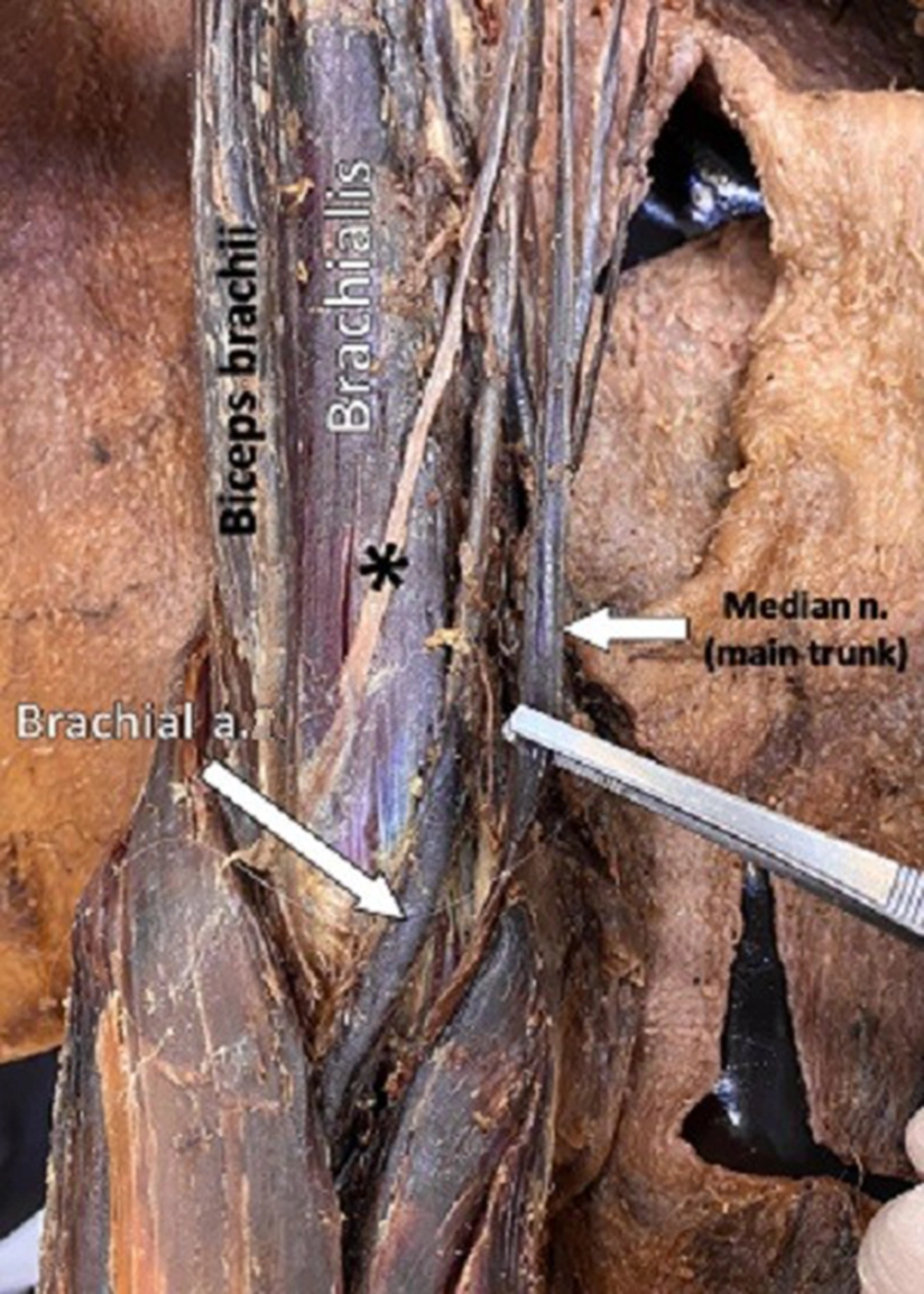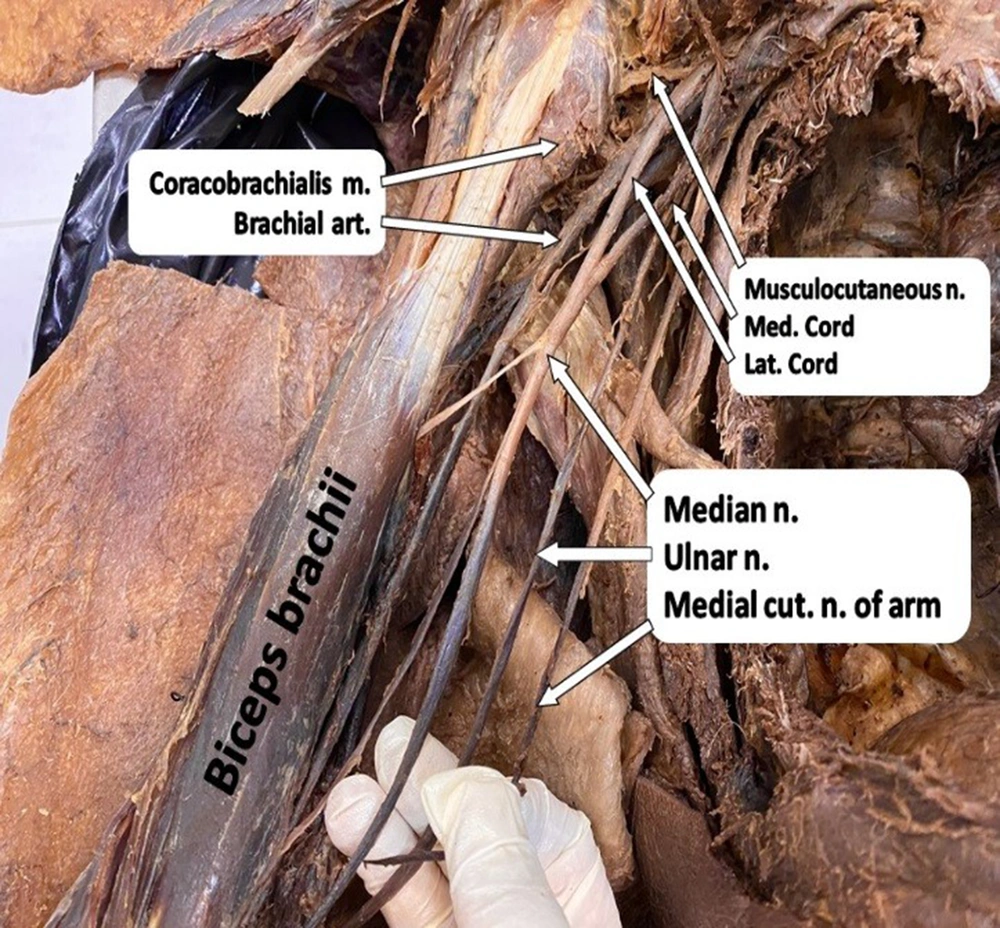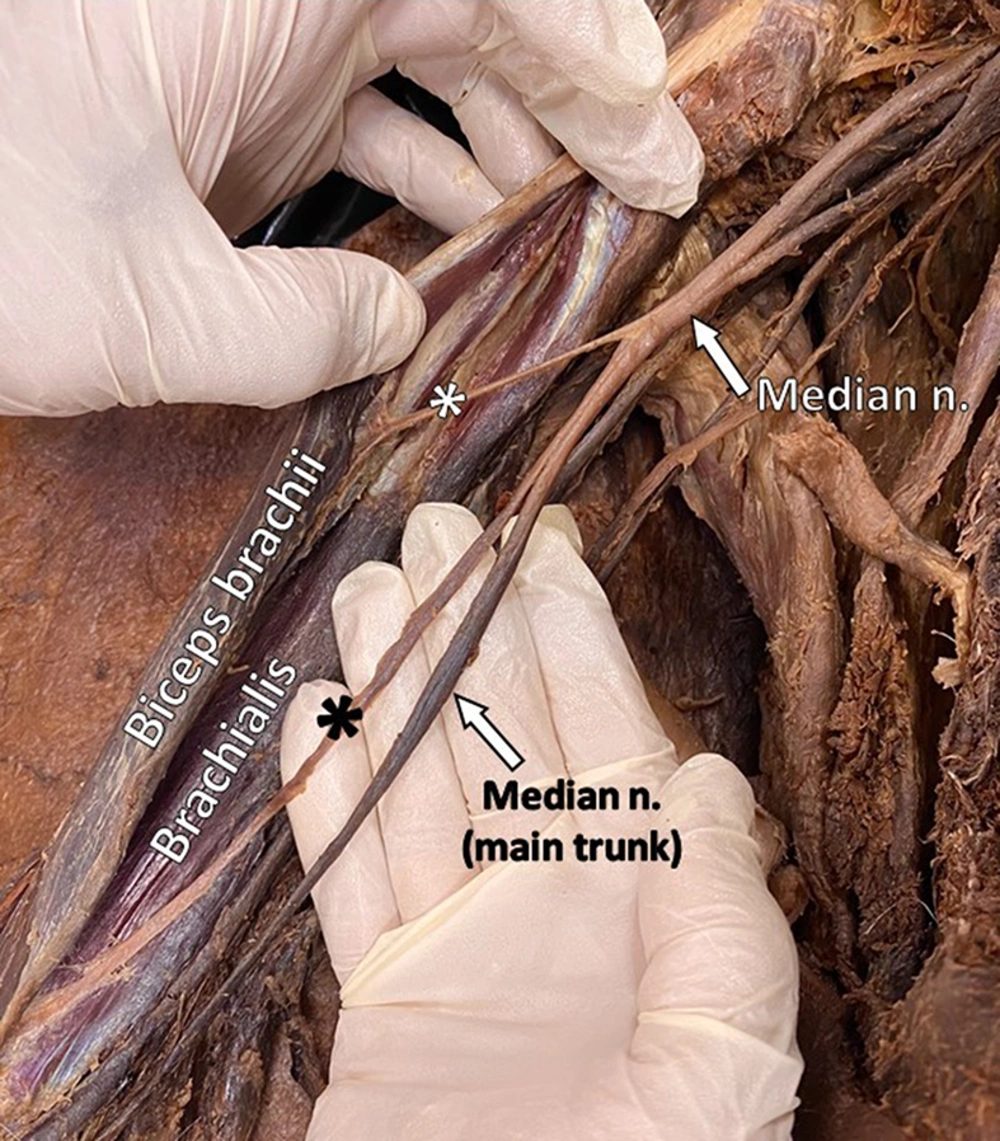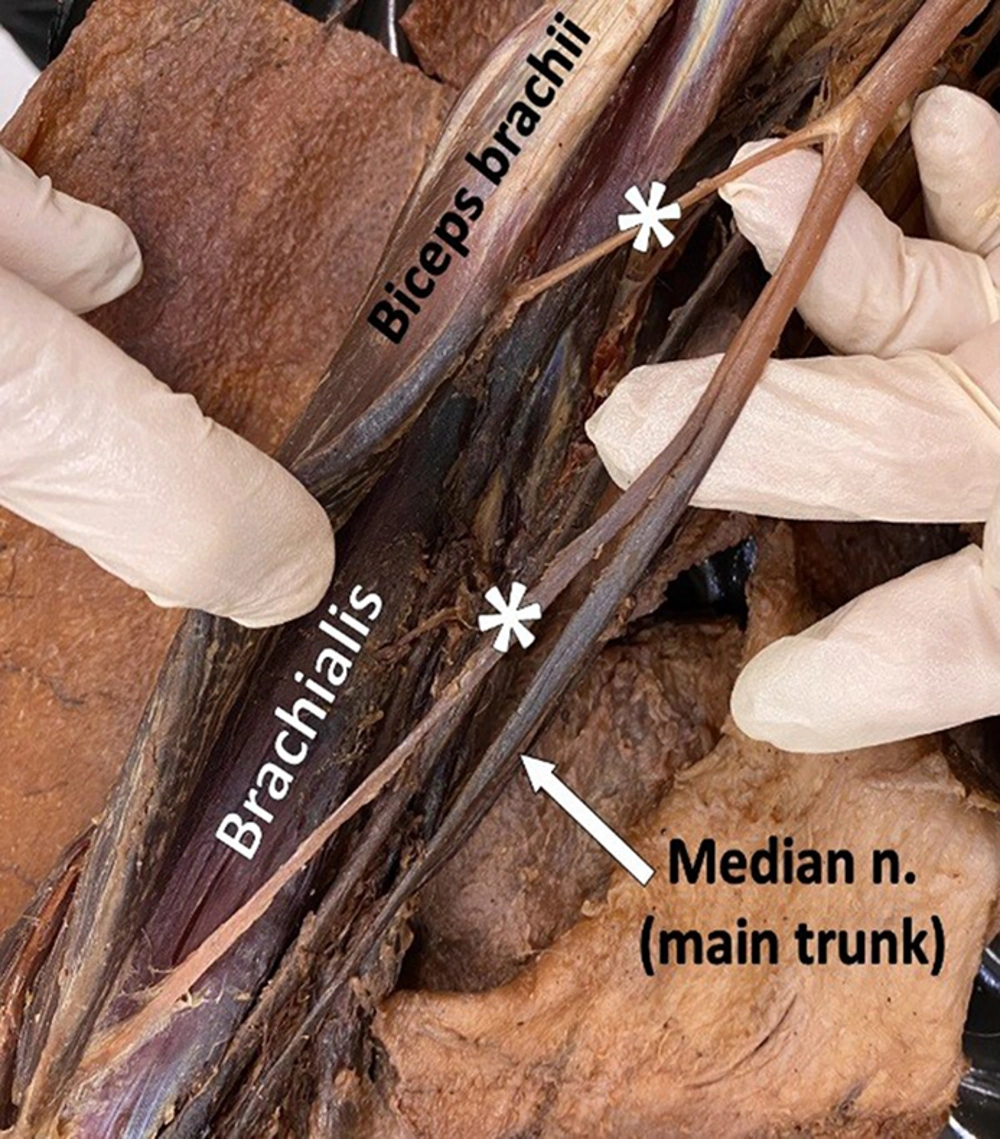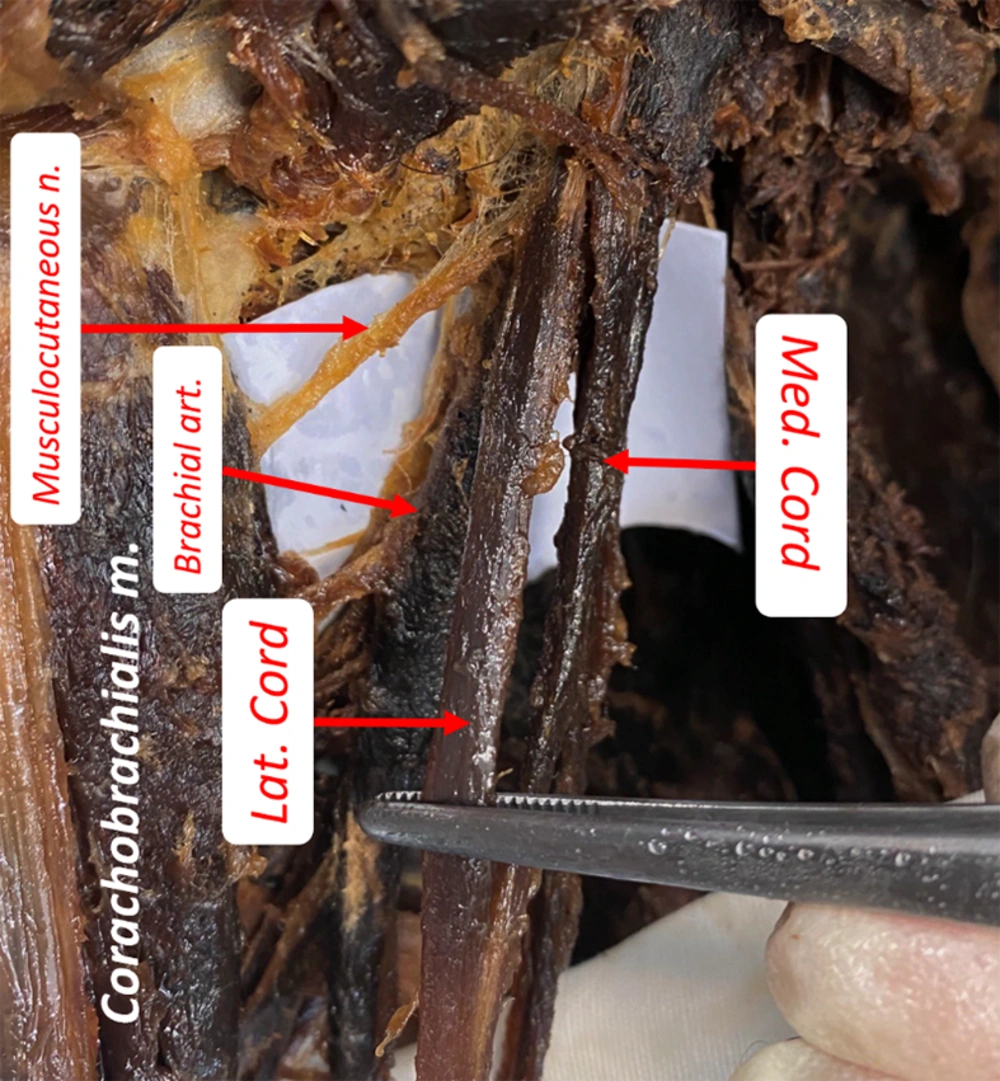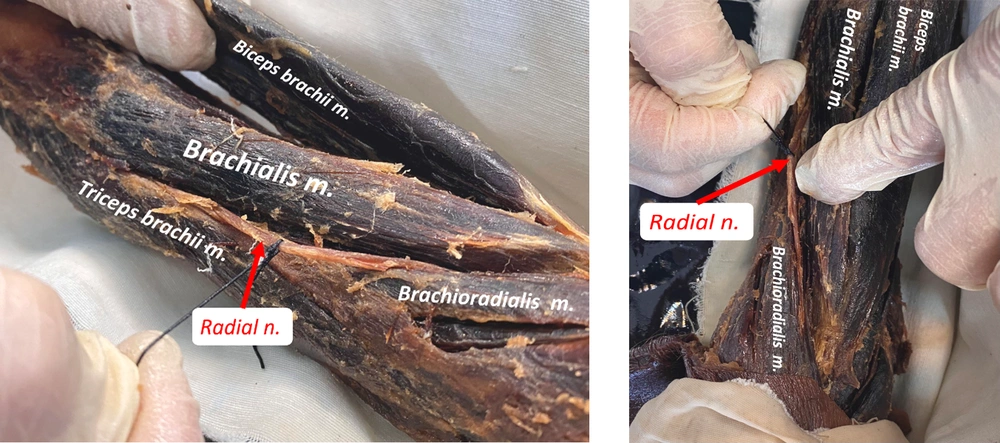1. Introduction
Innervation of the upper limb is the role of the brachial plexus branches. It arises from the union of the ventral primary rami of the fifth cervical nerve (C5) to the first thoracic nerve (T1). Variations may occur during the formation of the brachial plexus and its terminal branches. The anterior compartment of the arm consists of three muscles, namely biceps brachii, coracobrachialis, and brachialis. All three muscles are innervated by the musculocutaneous nerve. This nerve is one of the branches of the brachial plexus lateral cord formed by joining the branches of C5, C6, and C7 roots in front of the lower side of the pectoralis major muscle. It protrudes at the lower border of the pectoralis minor muscle and passes lateral to the axillary and upper part of the brachial artery. It leaves the axilla, pierces the coracobrachialis muscle, enters the elbow, and pierces deep fascia. Finally, it continues as the lateral cutaneous nerve of the forearm (1, 2).
The median nerve is formed by the union of the lateral and medial roots of the lateral cord (C5, C6) and medial cord (C8, T1) of the brachial plexus, respectively. This nerve is formed at the level of the distal border of the pectoralis minor muscle in front of the axillary artery. It innervates the muscles of the forearm, and it is unusual that the median nerve innervates the arm muscles (3-7). To prevent post-operative complications, precise knowledge of normal anatomy and such variations is important, especially for anesthesiologists and surgeons during axillary and upper arm surgeries. In addition, surgeons performing operations related to neoplasms or traumas must know these variations (8-11). The main goal of this study was to investigate the variations of the median nerve in the arm with a focus on its branching pattern and distribution.
2. Case Presentation
When dissecting the right axillary cavity of a 74-year-old male donor for medical students, the brachial plexus had a unilateral anomalous branching pattern. The musculocutaneous nerve was separated from the lateral cord of the brachial plexus and just innervated the coracobrachialis muscle. This nerve continued as the lateral cutaneous nerve of the forearm. The median nerve was formed by the union of the medial and lateral roots from the respective medial and lateral cords of the brachial plexus anterior to the axillary artery. The branches from the median nerve innervated the biceps, brachii, and brachialis muscles in the arm. The radial nerve does not innervate the brachialis muscle at all. Then, the median nerve entered the cubital fossa and innervated the muscles of the forearm and hand in addition to the hand skin (Figures 1 - 6). This condition was also observed in the contralateral limb.
3. Discussion
3.1. Description
Brachial plexus variations are common and can be justified from the embryological point of view. The upper limbs of the fetus develop during the fifth week of development. This process is influenced by homeobox genes expressed in the paraxial mesoderm. The growth cones of the motor axons enter the base of the limb bud to make the brachial plexus and extend into the limb bud. Many factors and chemoattractants can guide and route motor neurons, such as neutrin-1, neutrin-2, and brain-derived nerve growth factors. Any deviation in the expression of these factors and misplaced expression of them can lead to brachial plexus variations (12, 13). The brachial plexus is composed of ventral and dorsal segments. The roots of the median and ulnar nerves originate from the ventral root. The musculocutaneous nerve arises from the median nerve. The variations and anatomical anomalies of the musculocutaneous and median nerves can be attributed to the common origin of these two nerves. The interconnection between the musculocutaneous and median nerves can be considered as the remnant of the phylogenetic evolution. Comparative anatomical studies reported similar interconnecting branches in monkeys and apes. Such communicating branches in monkeys and apes are also found in comparative anatomical sciences (14).
In the study of Le Minor, all three flexor muscles of the arm were innervated by the median nerve (15). Beheiry reported a case in which both biceps and brachialis muscles were innervated by the lateral root of the median nerve. Moreover, the coracobrachialis muscle was innervated by a branch of the lateral cord (16). In the study by Pacholczak et al., the biceps and brachialis muscles were innervated by the lateral root of the median nerve, and the coracobrachialis muscle was supplied by the lateral cord (17). Shinde and Mane reported a case in which all three arm flexor muscles were supplied by the lateral root of the median nerve (18). In the present study, the biceps and brachialis muscles were innervated by the median nerve, and the musculocutaneous nerve supplied the coracobrachialis muscle.
3.2. Clinical Importance
The variations in the formation and relations of the median nerve in the arm have remarkable clinical importance. The surgeons and clinicians should be informed about these variations during the surgical procedures of the upper limb. For orthopedists and neurosurgeons, it is necessary to consider these anatomical variations for justifying paradoxical motor and sensory damage in patients. In addition, anesthesiologists need to be aware of the variations in the formation and location of the median nerve when they perform the brachial plexus block (19). Median nerve injuries in the arm region cause various complications, such as sensory, motor, vasomotor, and trophic disorders. Furthermore, injury to the median nerve in the axilla or arm would, in this case, have caused unexpected paresis or paralysis of the flexor musculature of the elbow (20).
3.3. Limitations of the Study
The limitation is that the present study illustrates a single-center experiment, and every dissection is completed using the identical procedure, with a minimal possibility of some anatomical variations being missed.
3.4. Conclusions
To our knowledge, this variation has not previously been reported in this country. The variations in the formation and relations of the median nerve in the arm have significant clinical importance for surgeons, clinicians, anesthesiologists, and orthopedists. Ignoring such variations can lead to diagnostic and therapeutic errors.
